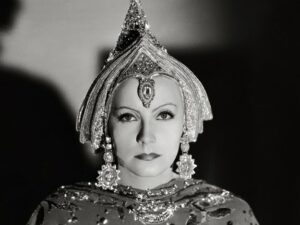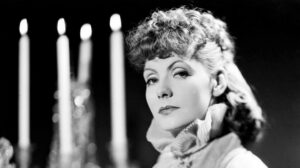Greta Garbo – Scandinavia’s melancholy

Greta Garbo is an unquestionable icon of cinema. The Scandinavian beauty brought to the big screen the breath of the far North, melancholy, and at the same time the charm of mysterious eroticism. Charming sad looks, sensual movements and dark blonde hair are the hallmarks of the divine Greta.
Greta Garbo – biography – European period
Greta Garbo – the most famous actress of the 1920s and 1930s – was from Sweden, born in Stockholm in 1905 as Greta Lovisa Gustafsson. She came from a working-class family. She dropped out of school at the age of 14 and began working as a salesgirl in a hat store at the PUB department store. At the same time she earned money as a model advertising the assortment offered by the store. The actress appeared in short videos to promote the brand being sold. She made her film debut at the age of seventeen, in 1922. It was a production of Erich Potschler’s “Luffar Petter”.
At the same time, the future star also entered the Royal Academy of Dramatic Art in Stockholm. Then her cooperation with the great director Mauritz Stiller began. It can be said that it was he who had a decisive influence on the whole acting of Greta Garbo. Stiller also invented the stage name of the star. In Sweden, the actress starred in a total of six films, including “Gösta Berlings saga” Stiller. In 1925, Garbo went to Berlin, where she appeared in Georg Wilhelm Pabst’s “Die freudlose Gasse”. Interestingly, however, Greta Garbo did not play a leading role in any of these films.
“Mysterious stranger” conquers Hollywood
In 1926 Greta Gustafsson, under the pseudonym Greta Garbo, came to the United States. Here her image was taken care of very thoroughly. Garbo was slimmed down, her hairstyle was changed, and aesthetic medicine procedures were performed. The actress underwent plastic surgery – her back teeth were specially removed, which highlighted her cheekbones. Initially the Metro-Goldwyn-Mayer studio wanted to promote Garbo as a charming tomboy with a simple haircut and shorts. However, this concept was quickly abandoned (contrary to the prevailing fashion trends) in order to show the actress as a sensual seductress. What is more, this new image became the basis for the star’s acting technique.

Greta Garbo in Mata Hari
One of the first films Greta Garbo appeared in in the US was Monty Bell’s “Torrent”, where she played a singer. Then followed a sprinkling of other roles: “The Single Standard”, “Felicitas”, “Anna Karenina”. Soon all of Hollywood had to bow to Garbo’s acting talent. The actress performed best in close-ups and slow-motion shots. She was incredibly photogenic and the camera really loved her. She was famous for her typical gestures: throwing back her head, melancholy gaze, romantic languor and moving to a musical rhythm. Nevertheless, the key to Greta Garbo’s success was not only her beauty, but above all the mystery inherent in her, hence the star’s nickname “mysterious stranger”. The star undoubtedly had an aura of the far North that was exotic to America.
Still in the silent film era, Greta Garbo began a passionate love affair with the amante of the cinema of the time, John Gilbert. The story of their love was extremely stormy, and the lovers were even to marry together. In the end, however, the wedding did not take place.
The sonic breakthrough – the triumph and fall of the divine Greta
The sound breakthrough, which became the reason for the downfall of many movie stars, was extremely stressful for Garbo herself. Producers were afraid that the low, harsh voice of the actress and, in addition, a foreign accent will not appeal to viewers. Nonetheless, the opposite happened: the first sound film starring Garbo, “Anna Christie” (1930), was met with great acclaim. In the film’s first scene, Anna, the main character, nonchalantly enters a dodgy pub and throws to the waiter serving her: “Give me a whisky!”. These were the first words spoken on screen by Garbo.

Garbo in Anna Karenina
The following sound films with the actress were also very successful: “Romance”, “Inspiration”, “Susan Lenox”, “Mata Hari”, “Grand Hotel”. One of the most important works in the star’s career is considered the “Camille” – a film from 1936, in which Garbo’s acting technique reached mastery. The artist for this role received one of the four Oscar nominations in her career.
However, the slow decline of the star was heralded by Garbo’s settling into an entirely new style – the comedic role. In 1939, the actress starred in Ernst Lubitsch’s film “Ninotchka”. The film was well received by audiences and critics alike, but the laughing Garbo in a completely new style was no longer the phenomenal diva of the screen. Another comedy with the Swedish actress, George Cukor’s a “Two-Faced Woman” (1941), turned out to be completely unsuccessful. It was the last film directed by Greta Garbo – a completely unsuccessful attempt to Americanize the image of the actress and her final defeat. Garbo was a fatal type of woman, full of secrets and magnetic eroticism, and the role of an amused woman, a woman-child, did not fit her at all. The actress herself was to say after this film: “they dug my grave”. Thus, Greta Garbo left the cinema at the age of only 36. In 1955, the star’s career was awarded an honorary Oscar.
After retiring from her acting career, Greta Garbo lived in New York. She never married or had children. Instead, she entered into lasting romances with women. She died in 1990, at the age of 84, her ashes were buried in a cemetery in Stockholm.
